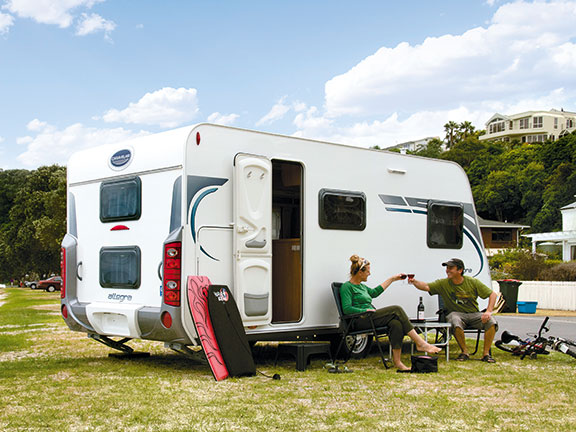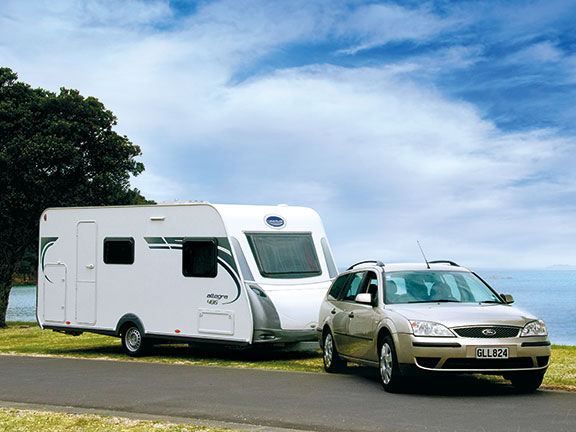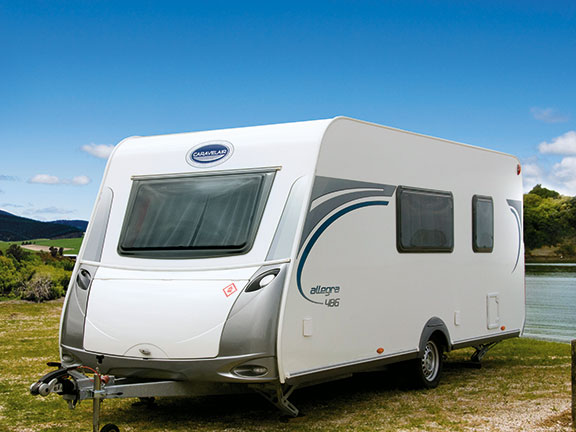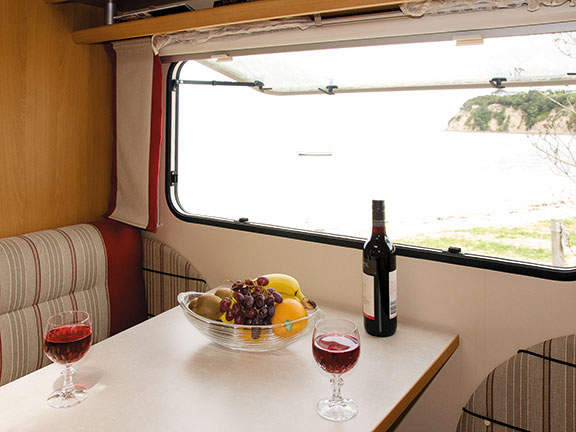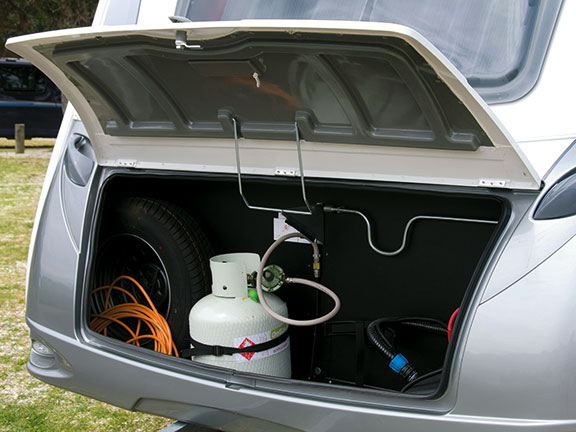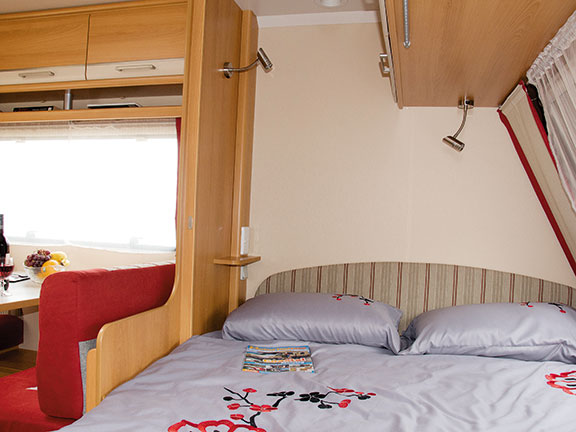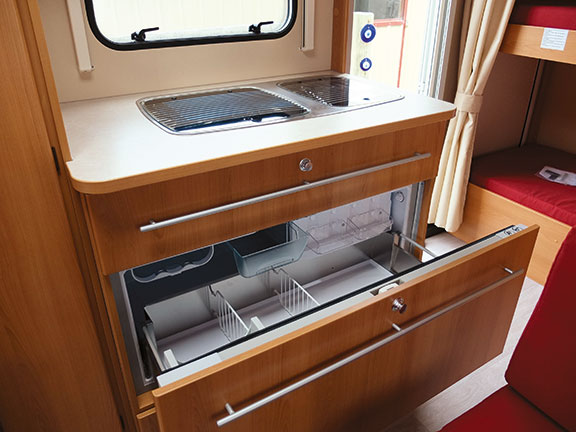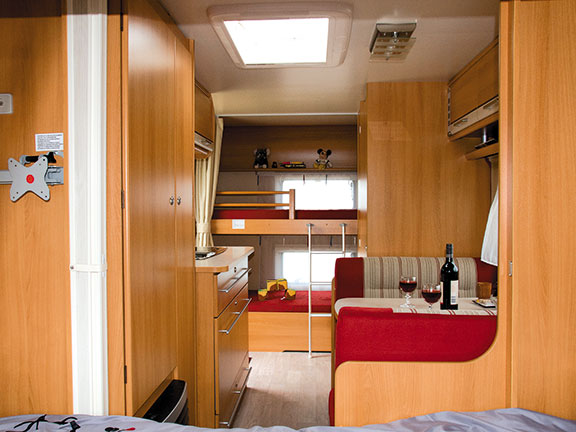I've had a lifelong interest in aviation, so the Caravelair name on the caravan I was to review had a familiar ring to it. A little research revealed the connection. In 1962, French aircraft manufacturer Sud Aviation diversified and began building motorhomes and, later, caravans. Sud Aviation marketed these RVs under the brand name 'Caravelair', the same name it had previously used for its most successful first generation commercial airliner. In 1970, Sud Aviation joined Nord Aviation to form Aerospatial and, shortly after, the Caravelair RV division became part of the Trigano VDL group. Today Caravelair is one of the leading names in caravans in Europe. They are manufactured in a Rhone Valley vineyard setting by Trigano VDL, which has 800 employees who annually design and manufacture more than 10,000 caravans and motorhomes at its 'state of the art' 200,000m² plant sprawling over the equivalent of 33 soccer fields. Currently, Trigano VDL manufactures six different brands of caravan and 15 different brands of motorhome.
The layout of the Caravelair Allegra 486 is aimed squarely at the family market. With two rear bunks on the back wall and a permanent double bed across the front, it is a practical layout for a young family. With a gross vehicle weight (GVW) of just 1400kg, the Allegra is light enough to be towed by a variety of two-litre family saloons – an important consideration these days with petrol around $2.20/litre (and rising) and diesel pump prices plus RUC not far behind. And, with waterside holiday home prices rising even faster, the total on-the-road price of the Allegra (starting at around $41,000) seems miniscule by comparison. No wonder caravan ownership is seen as an affordable holiday option by an ever-increasing number of Kiwi families.
The low tare weight (1120kg) is achieved by using foam sandwich construction in the walls, floor and roof. The structural integrity is very dependent on the outer skin, in this case glass reinforced polyester (GRP), and Caravelair is confident enough in its manufacturing processes to offer a five-year water-tightness warranty on its products. The exterior wall panels have a clean, smooth finish, without a hint of the contour of the underlying substrate showing through. A substantial alloy extrusion incorporating the awning track covers the join of wall to front, roof and rear panels. Just the job for attaching the attractive full-length awning that is included in the on-the-road price of this Allegra. Another extrusion runs the full length of the caravan at skirt height. It cunningly conceals an awning track for the full-length draught skirt, and there is even a short track built into each wheel arch trim – all important details that reflect Caravelair's response to customer needs. Incorporated into the ABS moulded lower front panel is a locker housing the 9kg LPG bottle, with holding straps provided for a second bottle if required. Typical of European/UK caravans, the locker floor is vented so is only really suitable for durable items like the certified self-containment standard portable waste tank, spare wheel and electric lead.
The Allegra 486, like all Caravelair caravans, is built on an Alko chassis and the 486 is fitted with an Alko 3004 anti-sway hitch and Alko corner steadies. The heavy equipment and appliances – house batteries, fridge, microwave and oven – are located in the centre of the caravan over the single axle, resulting in excellent weight distribution. Keep in mind that all caravans are safer to tow if heavy items of personal gear are stowed in the middle of the caravan while it is being towed – the Allegra will tempt you to overlook this maxim, as there is a lot of space under the double bed at the front and in the garage storage at the back that is best used for bulky light items rather than heavy ones.
As previously mentioned, the kids' bunks at the back are well separated from Mum and Dad's double bed at the front. Each bed has a quality, comfortable foam mattress over a slat base. Each bed has its own reading light and an opening window complete with insect screen and blind for ventilation. The stays that hold these windows open in various positions are an improvement over those I am familiar with; rather than a telescopic rod, these ones have a notched bar that you can see has engaged into a locked position. There are overhead lockers above the double bed for clothes and personal effects but not so above the bunks. However, the bunks are 2.1 metres long, so unless the kids are two-metre tall teenagers there is ample room to stow a sports bag or even a small suitcase containing their clothes at the end of the bunk. There is storage space under the lower bunk that can be accessed either from inside the 'van or through an oversized locker door that allows items as big as bicycles to be carried once the lower bunk is folded up against the rear wall.
The Allegra is not a large caravan, and providing a separate permanent sleeping space for four people in five metres of internal length suggests there will be a trade-off. In this case there is a dinette but no lounge – it seats four in comfort once you get used to the wheel-arch intruding into the foot space. The dinette can convert to a small double bed – 1680 x 1200mm – that would cater to kids rather than adults, but do you really need it?
Conveniently situated directly opposite the kitchen bench, the dinette table is bound to serve as an overflow bench at mealtime, as the kitchen bench is quite small – big enough for breakfast and preparing a snack lunch but tight for a full-blown evening meal. But hey, family caravans are used in the summer when the barbecue reigns supreme so it shouldn't be too much of an issue. It looks very smart with full-width drawers and there are plenty of cupboards for crockery, cutlery, pots and pans, as well as all the supermarket shopping. There is a small microwave in the overhead locker above the hobs but no oven or grill.
And that's not allowing for the storage in the novel Isotherm 150-litre (including a 19-litre freezer compartment) fridge/freezer. Conveniently placed under the kitchen bench, this fridge/freezer is a really 'cool' feature, with mobile dividers and various easily-removable shelves: three bottle holders to keep your drinks at the right temperature, vegetable basket, a meat tray, storage for eggs... Everything you need!
It is a 12-volt compressor fridge, so to provide 'juice' to run it on cloudy days in situations when mains power is not available, Euro-RV is fitting a 235-watt solar panel and a 20-amp MPPT regulator to keep the two 100amp/hr 12-volt AGM batteries (200amp/hr total) topped up.
Small but beautifully formed? Yes, the bathroom is, more or less – more for style, less for space. The trendy handbasin is of good size and shape and positioned so you can wash your face in it. Caravelair has formed a complex but functional floor/shower tray moulding that transforms this small space into a workable bathroom. This moulding has been matched to the beige colour of the Thetford 402 toilet – a nice point of difference to the white bathrooms we are accustomed to. The lighting is good and so is the ventilation, and there is a marvelous overhead locker for towel storage but there are no towel rails, clothes hooks or shower curtain – and while the faucet doubles as a shower hand-piece, you'd have to allow a few minutes of clean-up time after showering.
There is a water heater on board – a 230-volt Truma – plus a built-in 40-litre freshwater tank, a portable 30-litre grey water tank that meets self-containment standard, four 230-volt sockets and an insect screen on the access door.
When I hitched it up behind the Mondeo the car barely registered it; the unladen caravan depressed the tow bar less than 25mm. The Mondeo is fitted with a 17/8-inch tow ball and Alko hitches demand a 50mm tow ball, so I used Euro-RV's Toyota van to tow the Allegra across to the Whangaparaoa Peninsula for the photos. The Allegra was well behaved on the motorway and on suburban streets and the mechanical braking system worked perfectly; if correctly loaded the 'van will be very docile under tow. I didn't have to worry about backing the Allegra into position; Rainer from Euro-RV pushed it into place while I gave instructions.
The Allegra has a lot to offer for a caravan of such modest size – separate permanent sleeping spaces for four, nice handling and a practical fridge setup. Anyone in the market for a small family caravan will find a lot to please them. Supplied by Euro-RV, the Allegra 486 as reviewed comes with a full-length awning and is fitted with a 235-watt solar panel, a 20-amp Tracer MPPT regulator and two 100amp/h 12-volt AGM batteries. It retails for $49,500, including ORC and GST.
For further information contact Rainer Zeltwanger of Euro-RV Ltd on (09) 832 0064 or 021 266 3602.
For the latest reviews, subscribe to our Motorhomes, Caravans & Destinations magazine here.

